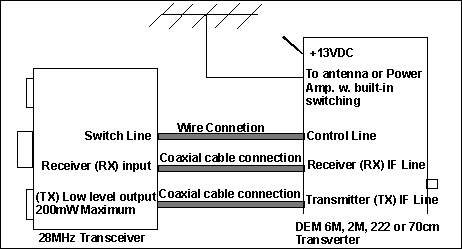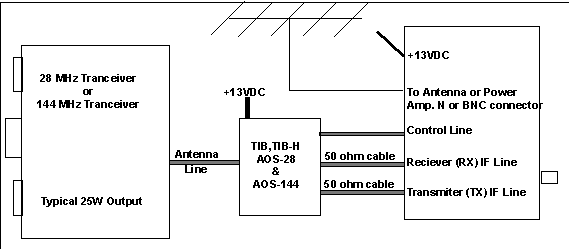Interfacing Down East Microwave Inc. (DEMI) Transverters
This document is provided to aid in the connection and operation
of DEMI transverters with most of the transceivers available on
the new and used market today. The guidelines here are by no means
the absolute, but will determine how we will configure your transverter
if purchased from us assembled or help you to decide what options
you will need if you wish to purchase a kit. The maximum advantage
of any DEM transverter is obtained by using the highest quality
IF (Transceiver) available. But don't let this deter you from
using a converted 11 meter transceiver for your IF. These have
been employed quite successfully for contesting, Earth / Moon
/ Earth, Rag chewing, and simplex FM operation. We have a lot
of experience in interfacing but we have not seen every type and
model in the world. If you are interested in using our transverters,
we will try our best to help. We just need you to be familiar
with your rig and to have an idea of what you want the end results
to be.
What is a Transverter?
A transverter is a receive converter and a transmit converter
joined by a common local oscillator. Its intentions are to convert
a transceiver to a different set of frequencies or band. It will
do so being totally transparent to the existing transceiver. This
means that most functions of the transceiver will also be the
same on the converted band. The transverter may be used in any
mode that the transceiver is capable of. All filtering, signal
processing, memory storage, scanning, frequency splitting, and
all of the other bells and whistles that your transceiver can
do, can be done on another band. There are a few things that are
not transparent to all transceivers. Two of them are power control
and frequency readout. Although there are a few transceivers on
the market that allow these two functions, most transceivers will
not. Power control is addressed in the transverter set-up and
can be adjusted in other ways. The frequency read out will become
a minor not noticeable inconvenience the more you use your system.
Why use a Transverter?
The two main reasons to use a transverter are Performance and
Economics. DEMI transverters are designed for the high performance,
weak signal enthusiast. Coupling one with a modern day, "High
End" transceiver, will offer you the highest performance
VHF-UHF-Microwave system available today! Yes, with the right
transceiver as an IF, they will out perform any VHF-UHF-Microwave
transceiver on the market today!
Being that a transverter
is an add on to an existing system, it now becomes economical.
It is not necessary to own more than one "High End "
transceiver to be on all of the VHF- UHF-Microwave bands in a
top notch style. Then at the other end of the spectrum, that $50
converted "CB Rig" now looks different when it can be
put on 6M through 70 cm with a little effort that might also turn
out to be fun to do!
What to look for!
After making a determination of what frequency output transverter
you wish to use, and understanding our transverter schemes, (6
meters through 70 Centimeters convert to 10 meters, and all transverters
900 MHz and up convert to 2 meters), consult the manual of the
desired transceiver. A lot of transceivers manuals are sometimes
confusing but most of the time the answers to the questions are
in there somewhere. And most of all , consult someone that is
using you rig with a transverter. Sometimes someone else's experience
is worth more than a manual with a translated instruction can
provide. Try to determine the following:
1. Does the transceiver have a transverter port. If it does, what
type. Is it TX only? RX only? or is it a common port? What are
the TX port output levels? Does the manufacture recommend any
reconfiguration of the transceiver before use? To our knowledge,
we don't know of a 2M transceiver with a transverter port!
2. If it is determined that a transverter port does not exist,
does the transceiver have a ALC input? If it does, what are the
maximum negative voltage levels specified? Also determine if a
+DC voltage can be supplied from the transceiver when it is powered
on. Some 2M transceivers qualify!
3. If still no luck, Is there a way that the power output can
be set not to exceed 25Watts? Most 2M and 10 M multi-modes are
this way. Also there are HF QRP rigs (5-10 watts) and some of
the newer transceivers can be programmed to a default of 10 watts.
These can all be used.
4. Last resort. Are you willing to modify or have your rig modified?
Consider investment and reversibility of the modification. But
a point to be made is when a mod is done correctly to a desirable
transceiver, it should enhance its value to the VHF-UHF and Microwave
enthusiasts.
If you fall into one of the categories above, you still need to
check out a few more things. We do not manufacture a RF sensed
transverter. All DEMI transverters require some sort of keying
control from a transceiver. Either a Push to Talk to Ground signal,
(PTT) or a Positive voltage on Transmit, (TTL) will work with
all DEMI transverters. Find out what you have and consider other
auxiliary circuits that you may want to operate from this signal.
Check for anything that may conflict.
If you have answered most of the questions and have a pretty good
idea what you are looking for, please call us and we can further
discuss your requirements, offer suggestions, help you get the
most bang for your buck!
Below are a few examples of some transverter systems showing their
interfacing. Please understand that we haven't any preference
when considering other manufactures transceivers to be used as
IF's for our transverters. The examples shown are a sample of
common 'Lash-ups" that are used in a transverter system
A typical radio to transverter connection would be as follows:
(most common set-up)
2 - 50 ohm Cables, 1 transmit, 1 receive, with BNC connectors
on one end, (for the transverter), and the other end will depend
on your transceivers connections. (DIN connector, RCA phono, BNC,
etc.)
1- Control wire pair preferably shielded, with an RCA connector
installed on one end for the transverter and the other again depends
on your transceiver.

A type of interface and a very popular one is to make use of a
10M or 2M 25 watt transceiver. The transceivers can be easily
modified or a DEM Interface that attenuates the 25 watts and separates
the transmit and receive lines for simple hook-ups while keeping
the transceiver in stock condition.

If you find that your radio is not transverter compatible, you
may want to modify or have your transceiver modified to provide
the necessary interface connections. In theory it is simple, but
due to a possible time consuming effort needed to modify some
of today's rigs, Down East Microwave at this time does not provide
this service. We will make recommendations and provide any amateur,
the documentation that we might have on file for your transceiver
free of charge. We are in the process of establishing a data base
with this such information and would ask for any information or
tips on any modification to any transceiver that is available
on the market today.
DEMI has many different ways to interface many different rigs.
We also have other auxiliary equipment such as intermediate converters
to convert 2M to 10M (144-28DC) This is used to convert all of
our microwave transverters to 28 MHz IF's. Many other
interfaces can be designed or just built to suit your needs. Some
of these interfaces can be built into a existing transverter.
Just call and ask!
So thank you for considering a DEM transverter and good luck with
your interfacing. If you have any questions or wish a product
description for any of our products, please call! Below is a brief
listing and description of interfaces that we carry in our catalog.
Most are available in kit form as well as assembled.
Transverter control IF switch with 24V relay driver
TRS T/R sequencer
AOS-XXX RF sensed 25 watt attenuator that splits transmit and
receive (144 or 28 MHz.)